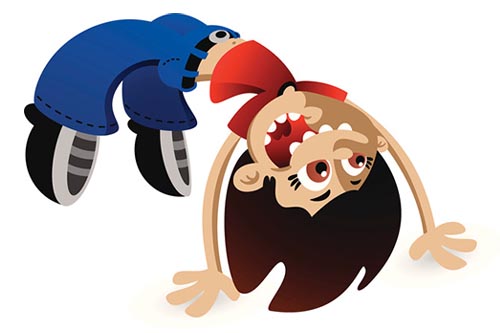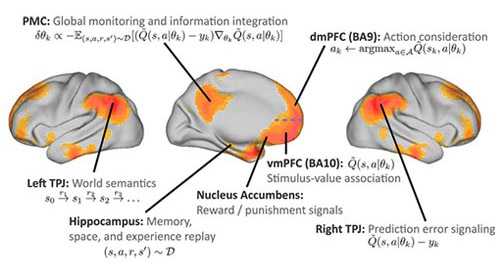
Don’t you just love this little terror?
I love working with kids. They’re so much fun, so easy to engage. They don’t get in their own way like adults do. They crave praise and acceptance. They smile and laugh so readily. They’re like sponges, curious, eager to learn, creative, responsive, enthusiastic, shamelessly proud of their accomplishments and, most importantly, so playful.
I get to work with them because they are equally saddled with an alphabet soup of modern childhood ‘problem’ labels that box them in, confuse them, turn them into unhappy little robots and perpetuate their feeling of helplessness well into adulthood.
A few days ago, I was introduced to the 12-year-old daughter of an acquaintance, a charming, lively, seemingly intelligent young girl. When I asked her to tell me about herself, the first thing she said with some amount of pride was “I have ADHD” followed by a long expectant pause that, I supposed, was meant to accommodate a reaction along the lines of “Oh, I’m really sorry to hear that, you poor girl.”
You could have knocked me down with a feather.
I have worked with kids of all ages (some well into their 80’s ![]() ) and I have seen the long lasting damages to the physical and mental health of our growing children caused by this relatively recent phenomenon of labelling kids with a whole alphabet soup of deficiencies from ADD to ADHD, OCD, ODD, BPD, ad infinitum.
) and I have seen the long lasting damages to the physical and mental health of our growing children caused by this relatively recent phenomenon of labelling kids with a whole alphabet soup of deficiencies from ADD to ADHD, OCD, ODD, BPD, ad infinitum.
Can you say ![]() M-I-C K-E-Y M-O-U-S-E
M-I-C K-E-Y M-O-U-S-E ![]() ?
?
How do we deal with these Third Millennium ‘disorders’
We medicate them for goodness sake! From the age of 6!!! Your six-year-old child can’t sit still in class? No problem! Here’s a Ritalin for them.
They don’t know whether they’re coming or going. They grow up anxious, depressed, moody. They act out. They rebel. They make our life miserable. So we put them in therapy.
Let me give you an example.
I met this highly intelligent, creative, artistic, talented 11-year old boy with an equally abundant alphabet soup of modern ‘deficiencies’ … A little terror. Violent temper tantrums. Abusive. Impulsive. Lying, cheating, fighting. Failing grades. Endlessly high on caffeinated drinks and sugary treats. Thrown out of one school after the other. In and out of psychiatrists’ offices. Arrested for stealing … more than once. Just a horrible naughty kid. Totally out of control.
An only child of very busy guilt-ridden parents who would compensate for their absence by giving in to all his trickeries, indulge him, buy him new toys, anything to keep him happy and quiet (sort of) … Need I say more?
By the time our little terror was referred to me, he was on yet another alphabet soup … that of the modern psychoactive drugs, all fighting each other for prominence in this poor little chap’s brain.
Would you be surprised to hear me say “It doesn’t have to be this way, and it can be sooooo easy to turn this problem on its head”?
How do you turn a child like that around?

You turn his world upside down by engaging him in playfulness rather than in the remedial actions he is used to.
Does that surprise you? It surprised him. He had lived with the “problem child” label for so long that it had become his ‘normal’, his “Default Mode Network” (more on that later), and every attempt at correcting his behaviour had been made from the perspective of ‘fixing him’.
The first thing I did was challenge him to a game of chess. I wanted to see how he responded to challenges. The bravado almost instantly dropped off and out came this delightful, bright, playful human being. Did I say you could have knocked me down with a feather?
More games followed. Each session became an occasion to shine, to show off his newly discovered talents and skills, to brag about acing his school tests, and to beat me at yet another math, word or skill game. He had to come up with a new story every week about a new corner of the world he was attracted to, its history, the people who lived there.
He showed an affinity for solving engineering and mechanical problems. We capitalized on that affinity and on his artistic flair and vivid imagination by playing all sorts of different games that were rewiring the circuitry in his brain and making him function and feel better. This new ability of his brain to focus was largely responsible for improvements in many areas.
I worked with him for several months and his grades went from an F average to a B+ (even sometimes getting As across the board), he dressed up for school like a proud young man, he made friends, his temper tantrums were less and less frequent, he learned to play an instrument and joined the school band … Did I say you could have knocked me down with a feather?
No, he did not turn into angel overnight, and he is still not angel, but I love the little bugger and I’m so proud of him. On our last day together, he drew me a lovely card that read “Best Teacher Ever”. Ahhhh!
Are you ready for a bit of science?
First off, there isn’t a ‘one size fits all’ answer. Our brains are very, very individual. There are so many possible combinations of neural connections that we are like snowflakes, no two are alike. But there are enough structural similarities between brains that we can use some heuristics, or rules of thumb, to guide us. So, say hello to your Default Mode Network, your DMN.

Your Default Mode Network is your autopilot. Do this, tap the top of your head and leave your finger there while you read the next few lines. In order for you to accomplish this simple task, you had to recruit billions of nerve fibres to work together toward that goal, and to do it on automatic. This is the job of the DMN. In a way, your DMN is YOU.
Your DMN is a very stable and efficient structure. Your brain minimizes the energy and time needed to get any job done. The downside of this efficiency is that your Default Mode Network can get itself stuck in a suboptimum configuration.
Imagine Indiana Jones getting stuck in an underwater air pocket too deep for him to take a breath and get out. Indie is in a suboptimum situation. Now, if I can give Indie some extra breath, he can get out of the cave. In the same way, if I can disrupt, educate, nudge, tease a kid’s DMN, then their DMN will spontaneously reorganize itself.
By strategically nudging a kid’s Default Mode Network with games and effortful challenges and focussed activities, we can help them reprogram their brain so they can function better and have the tools to do this anytime they need or want to in the future.
Are all kids so easily treatable?
Our little terror was an extreme case, no doubt, but the answer to that question is … it depends. If the ‘problem’ is psychological, the answer is an emphatic yes. If they have a neurological disorder caused by, say, a genetic flaw, or a traumatic injury, for example, the process takes longer because you are building new pieces of the brain … literally. But the underlying process is the same.
I have worked with many kids labeled with one or more varieties of the darn alphabet soup. Often they were not misbehaving, they were simply lost, anxious, they felt helpless, they had difficulties grasping new learning, they were overmedicated, confused, underachieving, or they were living in difficult circumstances:
- Divorced parents
- Dangerous neighbourhoods
- Pressure to achieve
- Pressure to fit in
- Physical disabilities
- Economic hardships
- No one to talk to about life
Others are traumatized at a very young age through no fault of anyone, and by the time the problem and its causes are discovered, their wiring has already gotten itself so twisted and deeply anchored that their caretakers are at a loss for a solution.
I worked with a 4-year-old girl who had become sleep phobic at the age of two (2 years old!!) when this poor little tyke had gotten an infection in both ears at the same time. She couldn’t explain to her mommy and daddy that the pressure she felt when she lay down was unbearable. By the time her parents realized the nature of the problem, half a lifetime of fear and poor sleep had turned her into an introverted zombie. She lived in a constant fog and would not respond to stimulation.
We used a very mild brain calming device over a period of 90 days while we engaged her in playful activities to gradually bring her out of the fog and back to being a normal lively sweet little girl. You couldn’t look at this joyous little miracle without tearing up for the longest time.
Of course, there is no shortage of teenagers and young adults who feel crushed by the pressure of their labels (can you say “Clinically Depressed”?) and bewildered with who they are supposed to be and how they are expected to perform. That would fit pretty well any teenager I have ever known at one time or another during those difficult formative years. Did I say it doesn’t have to be that way?
And what about the child inside all of us who has soldiered on bravely and quietly with the unresolved traumas or mysteries of our youth?
What can I do?
If you know a child, or have a child inside you, who could do with a little play time to teach their brain to feel and function better, please drop me a line and let’s see how quickly we can turn their world upside down and get them out of the soup.
Try this:
|
Let me know how it goes for you.
- Have you ever been knocked down with a feather?
- Were you ever a little terror?
- How do you handle the little terrors in your life?
Post your questions or answers below and read what others are saying.
What I’m Watching:
My goodness!
Me? ADHD?
Yet, how can I argue?
InJoy!

Leave a Reply